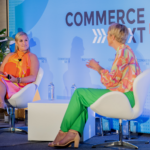CommerceNext brings insider insights from retail and ecommerce experts on how to unify digital and physical experiences. According to a Harvard Business Review study, customers who use multiple channels spend 10% more online than those who shop using a single channel, making it clear that omnichannel is essential for growth. We’ll share top omnichannel retail examples and the technologies driving their success.
Beauty & Cosmetics
Sephora Skyrockets Sales with Inclusive Customer Profiles
Sephora sets the beauty industry’s gold standard for omnichannel. Since 2010, the app has unified online and offline behavior into one profile, boosting loyalty and driving cross-channel sales with personalized rewards.
Say a customer comes into Sephora for a new foundation. The Color IQ tool scans their skin tone and assigns a unique ID, instantly matching shades across brands. This ID links to their profile, making future color matches easy, whether online or in-store.
Sephora offers a similar personalized experience for skincare, matching products to each customer’s needs.

(Source: Sephora Beauty Community)
Customers in the consideration phase can scan a product’s barcode to view details, reviews and real customer photos from Sephora’s online community. The app also lets users filter by preferences, personalizing the search experience.
For those not ready to purchase in-store, Sephora offers BOPIS and same-day delivery through Instacart and DoorDash, letting customers shop on their terms while cutting shipping times and costs.
Most importantly, the Sephora app consolidates data across all channels into a unified customer profile. It offers personalized recommendations based on in-store activity and rewards in-app shoppers with exclusive perks, early access to products and limited promotions. The “Beauty Insider” profile saves purchase histories, streamlining online replenishments and in-store returns.
Sephora’s robust omnichannel retail strategies have contributed to its impressive financial performance. According to Forbes in January 2024, Sephora drove its 2023 sales past $20 billion, maintaining a consistent 25% YoY revenue growth.
Glossier Succeeds at Physical Retail Thanks to Online Customer Data
Glossier, a digital-first beauty brand, integrated online and offline shopping through tech-driven omnichannel strategies. Built on social commerce and community engagement, Glossier transitioned from DTC and social media reliance to physical retail effortlessly.
Glossier leverages user-generated content, AI and customer data to personalize shopping and build loyalty. AI-powered email and SMS campaigns deliver tailored offers, boosting retention. Its app and website feature AR for virtual try-ons and AI-driven shade matching, reducing returns and increasing conversions.
When Glossier first opened physical stores and pop-ups, they used customer data to pick store locations and maximize local demand. In-store, RFID technology tracks customer interactions, optimizing inventory placement and sales opportunities.
Glossier maintains a seamless online-to-offline experience. In-person customers access their profiles via app, while AI-powered tablets help associates deliver personalized recommendations, replicating the online experience.
Glossier’s flagship stores also offer BOPIS. Customers can choose same-day delivery through third-party logistics, merging digital and physical shopping.
Above all, Glossier built its community on boosting customer confidence with natural products and aesthetic social media content. Its stores encourage UGC, with social-friendly designs and interactive features.
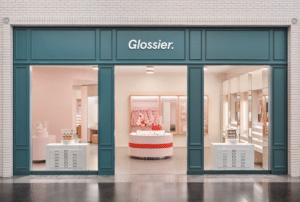
(Source: Glossier)
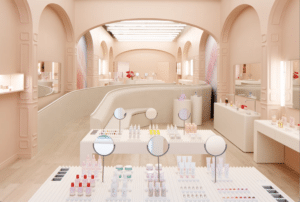
(Source: Glossier)
The iconic “You Look Good” mirrors, a social media favorite, prompt customer photos and feature QR codes linking to product details for a seamless digital experience.
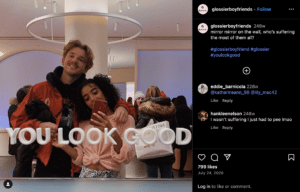
(Source: Glossier’s Instagram)
Food & Beverage
Starbucks’ Loyal Community Champions Online and Offline Ordering
Starbucks’ mobile app powers its omnichannel strategy, with nearly 25% of transactions through mobile ordering. Customers can order ahead, track in real-time and pay easily with the reloadable Starbucks Card, streamlining purchases and “star” rewards*.
Starbucks uses AI engine Deep Brew to analyze customer behavior and deliver personalized drink recommendations. These targeted order suggestions boost in-store engagement and spending. AI also helps plan new store locations based on app engagement and purchase patterns.

(Source: LinkedIn)
Starbucks Odyssey, their web3-powered community extension, redefines loyalty by using blockchain and NFTs for interactive experiences. Invite-only customers earn NFTs through “Journeys”—digital challenges like trivia and sustainability tasks—and unlock exclusive rewards such as virtual experiences, events and limited-edition merchandise. This gamified approach deepens engagement, extending loyalty beyond transactions.

(Source: TechCrunch)
To the public’s dismay, Starbucks’s NFT Beta ended in March 2025 in continuation of evolving the program.
For physical stores, Starbucks has invested in digital-first store models, including mobile pickup-only locations in urban areas. Drive-thru, curbside pickup and delivery through Uber Eats and DoorDash offer convenience. Customers can even order via Alexa or Google Assistant.
Starbucks has cultivated a fiercely loyal community with deeply ingrained habits and brand affinity. Drive-thru and mobile orders now account for 70% of U.S. sales, with delivery orders increasing YoY. In particular, the Starbucks Rewards program drives over half of Starbucks’ U.S. revenue, with loyalty members spending 3x more than non-members. In 2023, Starbucks claimed over 31 million active reward members in the United States.
*Starbucks Rewards members earn “Stars” with every purchase, redeemable for perks or discounts.
Healthcare, Wellness & Pharmacy
Walgreens Cuts Prescription Fulfillment Time with Mobile App
Walgreens’ omnichannel strategy blends retail and healthcare, creating a unified ecosystem. To combat revenue loss from poor inventory management, Walgreens invested in AI, automation and mobile technology to streamline its app and prescription services.
Walgreens’ mobile app boosts efficiency and convenience. Customers can refill prescriptions with real-time tracking and check local store inventory instantly.
Concurrently, Walgreens cut wait times by investing in robotics and AI-powered micro-fulfillment centers. Automation predicts demand, streamlines inventory and frees pharmacists to focus on care—not manual tasks.
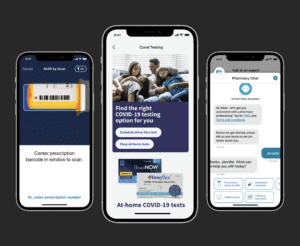
(Source: Walgreens)
The result? Walgreens processes prescriptions 50% faster than traditional methods. Automated refills improve retention by keeping orders ready and on time.
The Walgreens app now handles 33% of all prescription refills and serves over 102 million users, with app users spending 4x non-app users.
To strengthen in-store engagement, Walgreens expanded into telehealth through its VillageMD partnership, letting patients consult doctors and manage prescriptions online. AI recommends wellness products based on health data, while users schedule vaccines and access digital prescriptions in-app. This digital-physical integration drove 25% growth in healthcare revenue, with plans to open 1,000 primary care clinics by 2027.
The “myWalgreens” loyalty program drives retention with personalized deals, real-time discounts and AI-powered health tips. Customers earn points across all channels and redeem rewards twice as often when using both online and in-store services.
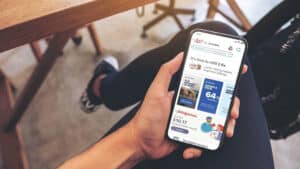
(Source: Walgreens Boots Alliance)
Walgreens also streamlined fulfillment with BOPIS, drive-thru and curbside pickup—40% of digital orders are now ready within two hours. Same-day delivery via DoorDash, Uber Eats and Postmates adds convenience. Since expanding these services, online orders have surged 116% YoY.
Apparel, Footwear & Accessories
Fabletics Carries Customer Personalization from Online to In-Store
Fabletics’ VIP membership program offers exclusive pricing, rewards and curated outfits through a monthly subscription. AI tracks preferences and predicts trends, personalizing recommendations based on past purchases. Members enjoy facilitated shopping across platforms, maintaining discounts and perks. VIPs spend an average of 2.5x more than non-members.
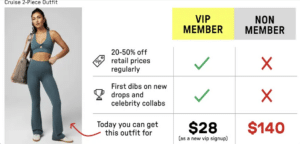
(Source: Fabletics)
Online VIP members enjoy personalized experiences and products—and Fabletics brings this same luxury to physical stores through technology.
Fabletics fitting rooms use RFID technology to create an easy shopping experience. RFID sensors display items on a touch-screen mirror, allowing shoppers to request different sizes, colors or similar products without leaving. Data from online purchases drives personalized, in-store styling recommendations.
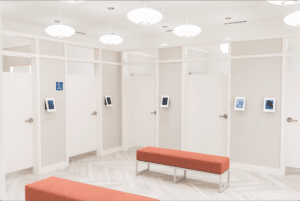
(Source: Fabletics at Disney Springs)
Fabletics uses digital insights to pinpoint high-demand locations before opening stores. Each store reinforces the brand with fitness classes, community events and digital touchpoints, turning shopping into a holistic lifestyle experience.
Interactive displays let customers browse the full online catalog in-store. BOPIS, easy exchanges and curbside pickup offer flexible fulfillment, driving store visits and cross-channel sales. In-store digital checkouts—via app, self-kiosk or POS—ensure quick purchases.
———
Each year, the CommerceNext Growth Show exhibits case studies and in-depth analyses of how major retailers are leading omnichannel integration and aligning inventory and marketing efforts.
Interested in attending? The wait is over–our conference returns to NYC this June 24-26th! With 2,700+ attendees, 150+ speakers and 75+ sessions, the CommerceNext summit facilitates partner relationships and community building for retailers and solution providers.
If you’re a retailer and interested in attending, you can register for the conference here.
If you’re a vendor and interested in getting involved with our retail community, explore our sponsorship opportunities. Book an intro chat with CommerceNext–we’d love to meet you!
Related Posts
-
Retail Omnichannel Strategy: How to Meet Multi-Channel Demands
Retail is evolving everyday. Today, it is now a dynamic…
-
Exploring the Power of Omnichannel Retail with Trina Turk and Amazon Today
The CommerceNext 2023 Ecommerce Growth Show was full of insights…
-
Retail Omnichannel Strategy: How to Meet Multi-Channel Demands
Retail is evolving everyday. Today, it is now a dynamic…


